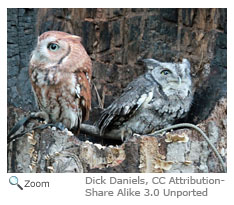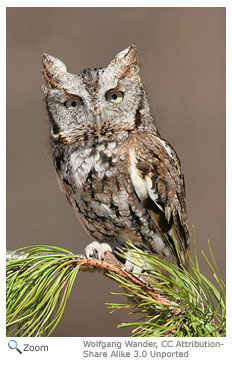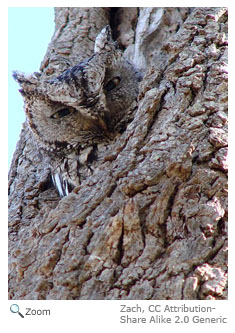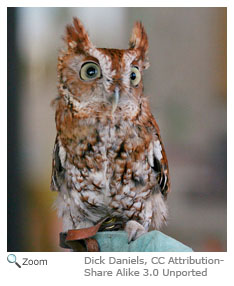Description
 Only 10 inches tall and well -camouflaged, the Eastern Screech Owl is more often heard than seen. Its body can either be gray all over or rufous, a brownish-red color with dark streaks. Both colors make the Eastern Screech Owl very difficult to see against the bark of trees, where it lives. In addition to large ear tufts, the little owl has large yellow eyes and a yellow beak. Only 10 inches tall and well -camouflaged, the Eastern Screech Owl is more often heard than seen. Its body can either be gray all over or rufous, a brownish-red color with dark streaks. Both colors make the Eastern Screech Owl very difficult to see against the bark of trees, where it lives. In addition to large ear tufts, the little owl has large yellow eyes and a yellow beak.
Range
The Eastern Screech Owl is found throughout eastern North America, from the Rocky Mountains to the Atlantic coast. Its range extends from southern Canada south to Florida and Texas.
Habitat
 As long as there are trees with cavities for nesting, the Eastern Screech Owl might be there. It is found in almost all habitats below 1500 meters, including urban, suburban and heavily forested areas. The Eastern Screech Owl easily acclimates to human presence and will use bird boxes for nesting. As long as there are trees with cavities for nesting, the Eastern Screech Owl might be there. It is found in almost all habitats below 1500 meters, including urban, suburban and heavily forested areas. The Eastern Screech Owl easily acclimates to human presence and will use bird boxes for nesting. |
|
Diet
 With the most varied diet of any North American owl, the Eastern Screech Owl will eat almost any small animal. It eats many small mammals including rats, mice, squirrels and rabbits. It also eats small birds such as finches, blue jays, doves and woodpeckers. The Eastern Screech Owl feeds on many invertebrates such as earthworms, insects, crayfish, tadpoles and frogs. It even preys on bats! With the most varied diet of any North American owl, the Eastern Screech Owl will eat almost any small animal. It eats many small mammals including rats, mice, squirrels and rabbits. It also eats small birds such as finches, blue jays, doves and woodpeckers. The Eastern Screech Owl feeds on many invertebrates such as earthworms, insects, crayfish, tadpoles and frogs. It even preys on bats!
Life Cycle
 The Eastern Screech Owl chooses a tree cavity for her nest. She doesn't build a nest, but rather makes a depression into the material already in the cavity. The female lays 3 to 4 eggs but could lay as many as 7. She incubates the eggs for 26 to 34 days. While the female incubates the eggs, the male feeds her and guards the nest. After hatching, the chicks fledge at 28 days but stay with the parents until 8 to 10 weeks old. At that point, they are old enough to feed themselves. The Eastern Screech Owl chooses a tree cavity for her nest. She doesn't build a nest, but rather makes a depression into the material already in the cavity. The female lays 3 to 4 eggs but could lay as many as 7. She incubates the eggs for 26 to 34 days. While the female incubates the eggs, the male feeds her and guards the nest. After hatching, the chicks fledge at 28 days but stay with the parents until 8 to 10 weeks old. At that point, they are old enough to feed themselves.
Behavior
 An easy way to find the Eastern Screech Owl is to listen for the commotion made by their prey: blue jays, chickadees and titmice. During the day, these birds swoop around the Screech Owl, alerting other birds that the owl is there and trying to make the owl move to a new spot. An easy way to find the Eastern Screech Owl is to listen for the commotion made by their prey: blue jays, chickadees and titmice. During the day, these birds swoop around the Screech Owl, alerting other birds that the owl is there and trying to make the owl move to a new spot.
The Eastern Screech Owl is very territorial. It has been known to strike humans on the head if they pass too close to a nest at night. |





